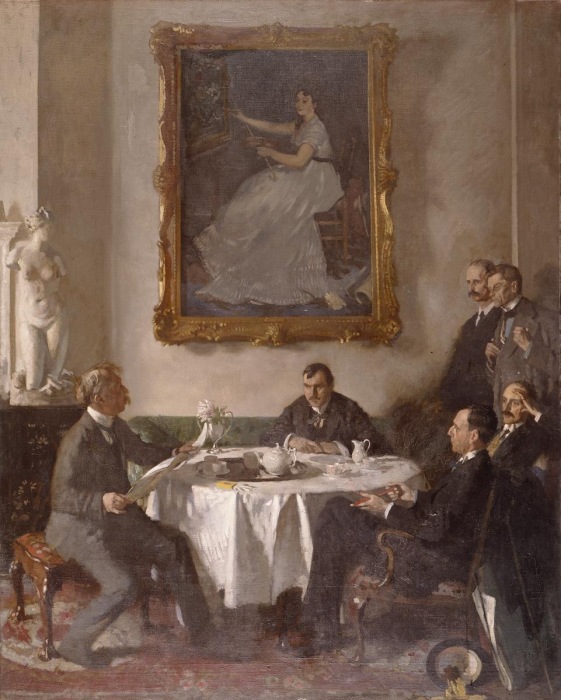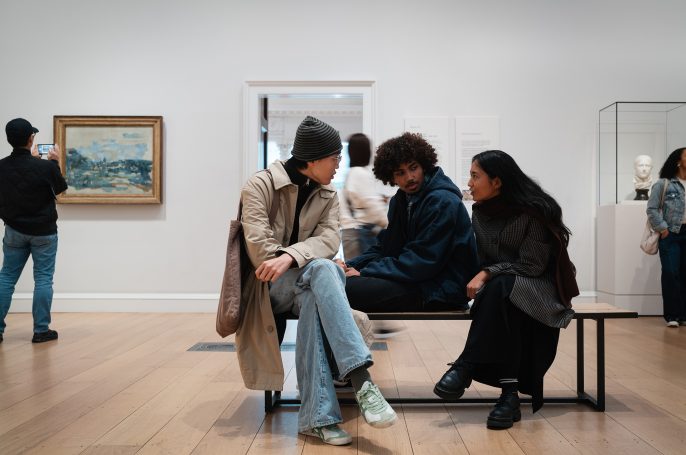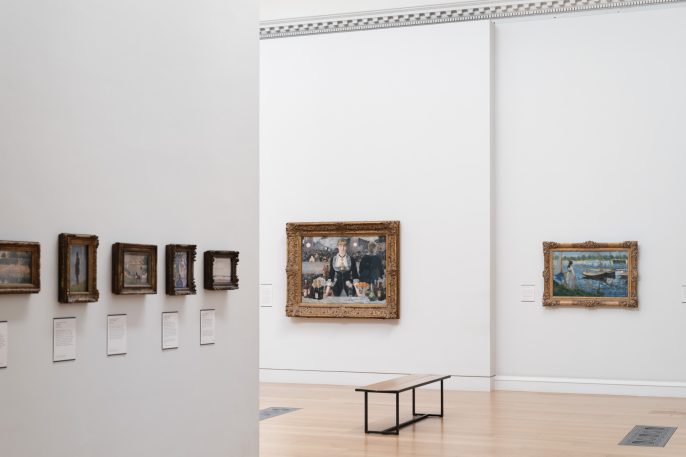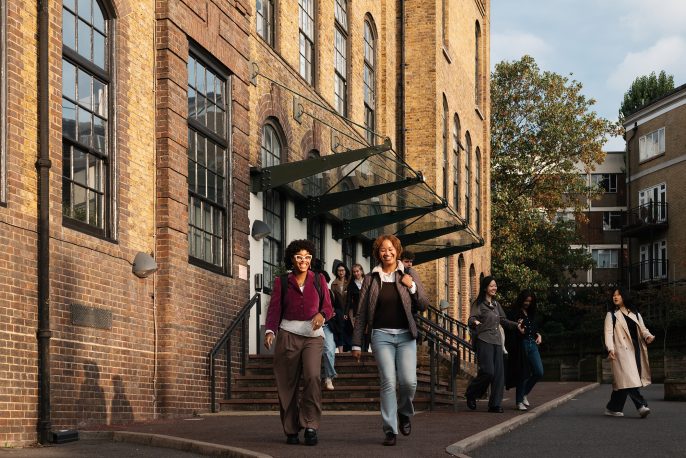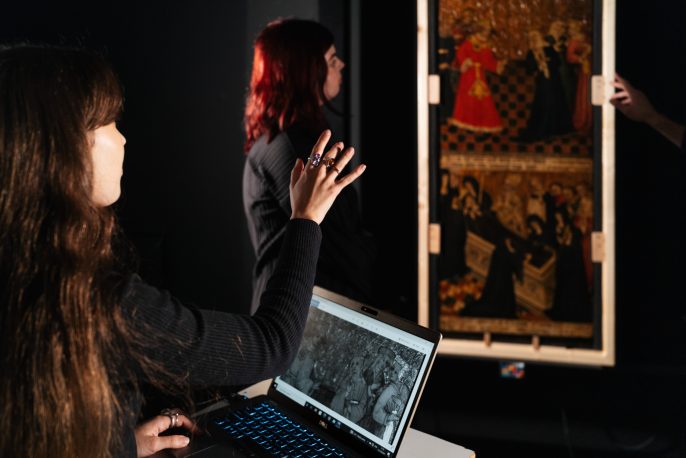This conference will explore the development in Britain of the taste for French Impressionism between 1870, when Paul Durand-Ruel established his Bond Street gallery, and 1917, when the National Gallery in London accepted the Sir Hugh Lane Bequest. Despite Durand-Ruel’s early support of Monet and his contemporaries, Impressionism’s acceptance by the public in Britain was cautious and slow, hampered as much by limited access to the works as by the hostility of the market and the absence of a pertinent vocabulary by which it could be mediated by British critics. For much of the period in question their work was misunderstood, considered sketch-like and inconsequential.
In the period leading up to the First World War, few collectors were interested in buying Impressionist art. The exceptions were artists such as Walter Sickert and John Singer Sargent, and a group of ‘new rich’ industrialists who had made their fortunes through commerce. In the 1880s and 1890s, the only British dealers to exhibit and sell impressionist art in the UK were David Croal Thomson in London and Alexander Reid in Glasgow. Although this period was marked by a number of pioneering exhibitions, it was not until after the First World War that the market for Impressionism was firmly established.
This conference will present new research by leading scholars of Impressionism and of the history of collecting. It will examine the pioneering contribution of key artists and art dealers, as well as the relative reluctance on the part of collectors to appreciate the Impressionist agenda. Speakers will also examine the presentation of Impressionist and relatively more modern works in British galleries between 1870 and 1917.
The conference is organised and chaired by Professor Frances Fowle, Dr. Natalia Murray and MaryAnne Stevens, and Professor Steve Edwards, Manton Professor of British Art and Director of the Manton Centre for British Art, The Courtauld.
Conference Schedule:
10.00 – 10.15: Welcome, Introductory remarks
10.15 – 11.15: Session 1: Collecting Impressionism and its reception in Britain before 1917
Chair: Natalia Murray
Overview of Early collecting
MaryAnne Stevens
Durand-Ruel and his British collectors
Flavie Durand-Ruel
11.15 – 11.45: Coffee Break
11.45 – 13.30: Session 2: Early Collectors
Chair: Tom Stammers
Louis Huth (1821-1905): An Important Early British Collector of Degas
Dr Andrew Watson
Captain Henry Hill: an unexpected collector of French Modern Art
Dr Natalia Murray, Courtauld Institute
A Contradictory Collector: Sir Peter Coats’s Impressionist pictures in context
Professor Frances Fowle
13.30 – 14.45: Lunch Break
Provided for speakers and organisers only
14.45 – 15.45: Session 3: Artist Collectors
Chair: MaryAnne Stevens
John Singer Sargent: Impressionist Painter and Collector?
Elaine Kilmurray
A Collector Manqué?: Walter Sickert’s Brief Ownership of Impressionist Pictures
Dr Tom Stammers, Courtauld Institute
15.45 – 16.15: Coffee Break
16.15 – 17.15: Session 4: Collectors and Legacy
Chair: Frances Fowle
Hugh Lane: “He must always be doing for Ireland”
Chris Riopelle
‘The highest ideals in art’: Impressionism in south Wales, 1913-1914
Anne Pritchard
17.15 – 17.30: Final Words
17.30 – 19.00: Drinks Reception
Speakers:
Frances Fowle
Frances Fowle is Emeritus Professor of Nineteenth-Century Art at the University of Edinburgh. She previously held a Personal Chair in Art History and was Senior Curator of French Art at the National Galleries of Scotland for over twenty years. Her specialism is collecting and the art market and she has curated numerous international exhibitions on Impressionist and Post-Impressionist art. Her publications include Impressionism and Scotland (2008), Van Gogh’s Twin: the Scottish Art Dealer Alexander Reid(2010), Globalizing Impressionism: Reception, Translation and Transnationalism (with Clark, 2020), French Paintings 1500-1900, NGS (with Clarke, 2022) and The Art Market and the Museum (with Cleary, 2025).
Natalia Murray
Natalia Murray is a lecturer in modern art and curating at the Courtauld Institute of Art and a senior curator. She specializes in late nineteenth and early twentieth-century Russian and Western European art and is the curator of the Royal Academy’s major exhibition Russian Art 1917-1932 (2017). Natalia is currently working on several new exhibition projects in the US and in Europe. She has published widely: her most recent book, Two Women Patrons of the Russian Avant-Garde. Nadezhda Dobychina and Klavdia Mikhailova, was published in 2021 and was dedicated to the first gallerists in Russia. Her current research is dedicated to early collectors of French Impressionism in England.
MaryAnne Stevens
MaryAnne Stevens, erstwhile Director of Academic Affairs at the Royal Academy of Arts, London, is a scholar, independent curator, lecturer and consultant. She specializes in 18th-, 19th- and early 20th- century art, with particular reference to British, French and Nordic art in the second half of the 19th and early 20th centuries. She has taught and published extensively in these areas, and curated many exhibitions, covering Nordic art and French Impressionist, Symbolist and early Modern Art. Her most recent exhibition was ‘After Impressionism: Inventing Modern Art’, was presented at the National Gallery, London in 2023.
Christopher Riopelle
Christopher Riopelle is The Neil Westreich Curator of Post 1800 Paintings at the National Gallery. He has held curatorial positions at the J. Paul Getty Museum, CA, and the Philadelphia Museum of Art. Among exhibitions co-curated in London are Renoir Landscapes 1865-1883 (2007); Inventing Impressionism: Paul Durand-Ruel and the Modern Art Market (2015); Delacroix and the Rise of Modern Art (2016); Australia’s Impressionists (2016) and with MaryAnne Stevens After Impressionism (2023). Forthcoming in 2026 is Renoir and Love, a collaboration of the National Gallery with Musée d’Orsay, Paris, and Museum of Fine Arts, Boston.
Andrew Watson
Andrew Watson, associate lecturer with the Open University, is a specialist in nineteenth-century art, with an emphasis on collecting. He has written extensively on British collectors of French painting, including a book on the remarkable Scottish collector James Duncan of Benmore (1834–1905) and articles for the Société des Amis du Musée National Eugène Delacroix, The Metropolitan Museum of Art Journal, and Burlington Magazine. In his most recent Burlington article he definitively established the early history of Eugène Delacroix’s Death of Sardanapalus. Andrew has written seven entries for Charles Sebag Montefiore’s forthcoming (2027) Dictionary of British Art Collectors: 1600–1939.
Flavie Durand-Ruel
Flavie Durand-Ruel devotes herself to studying the fascinating life of her ancestor Paul Durand-Ruel (1831–1922), a visionary and innovative art dealer. At the Durand-Ruel Archives in Paris, she published, with her uncle, her ancestor’s Memoirs (Flammarion, 2014 & 2024). Since 2018, as FDR Fine Arts Director in Brussels, she researches provenance of pictures, published Tribute to Impressionism: Paul Durand-Ruel, dealer and friend of the Impressionists (2024) and works on the catalogue raisonné of Albert André. She participates in exhibitions and conferences, and studies the correspondence of Claude Monet, and Mary Cassatt to be published in 2026.
Tom Stammers
Tom Stammers is Reader in Art and Cultural History at the Courtauld Institute, and co-leader of the new MA in Art and Business. His first book, The Purchase of the Past: Cultures of Collecting in Post-Revolutionary Paris, c.1790-1890 (Cambridge, 2020) won the RHS Gladstone Prize. He was co-investigator on the major AHRC project ‘Jewish Country Houses: Objects, Networks, People’ (2019-2024). Tom has published widely on French art, the history of collecting, the art market, museums and heritage politics, and contributes regularly to publications including Apollo and the London Review of Books.
Elaine Kilmurray
Elaine Kilmurray is an independent scholar. She was Research Director of the John Singer Sargent catalogue raisonné and co-author, with Richard Ormond, of the nine published volumes of the catalogue (Yale University Press 1998-2016). She has co-curated exhibitions of Sargent’s work in London, the United States and Italy, most recently ‘Sargent and Spain’ (2022), and has written and lectured internationally on the artist and related subjects. She is interested in Sargent’s interaction with Impressionism and in his artistic relationship with Claude Monet.
Anne Pritchard
Anne Pritchard was Senior Curator at Amgueddfa Cymru, overseeing Historic Art and the renowned Davies Collection of Impressionist art. In addition to the redisplay of those galleries (2010), her exhibitions included France and Britain: Art for a New Age 1817-1917 (Japan, 2017-2018), and partnering with Tate to take Stott’s Le Passeur to west Wales (2018). Specializing in French art of the long nineteenth century, and particularly its relationship with national identities, her publications have included articles on the landscapes of Sisley, Monet, and Harpignies. After a sabbatical in the USA, she recently joined the National Galleries of Scotland.
